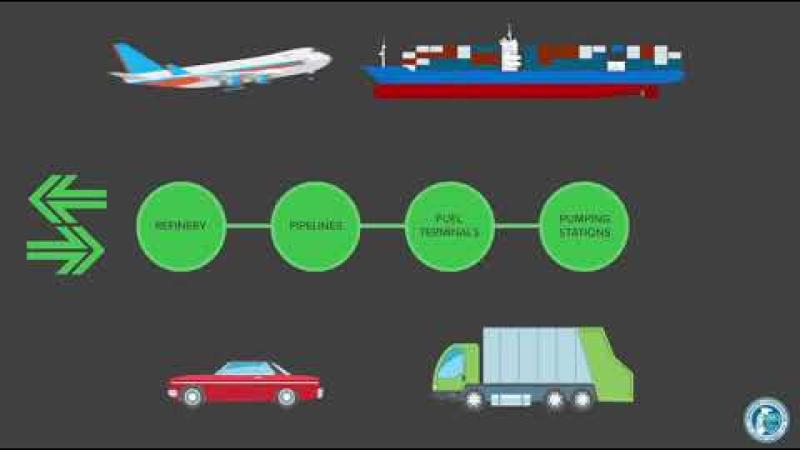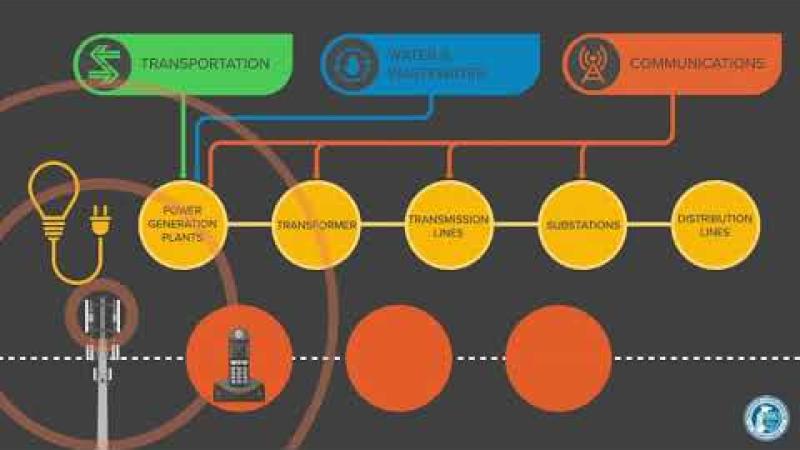
Infrastructure Dependency Primer
An Educational Resource
Welcome to the Infrastructure Dependency Primer (IDP)! This educational supplement to the Infrastructure Resilience Planning Framework is intended to help you better understand critical infrastructure, dependencies, the impact they have on communities, and how to improve resilience through planning.
Modules
The IDP is organized into three modules. These modules are meant to be explored in order or referenced individually based on your current knowledge, interests, and needs.
LEARN
This module gives an overview of some of the critical services provided to communities by infrastructure systems, as well as common dependencies these systems have.
Learn about:
- Communities as Systems
- What are Dependencies?
- A Closer Look
PLAN
This module shows how understanding critical infrastructure and dependencies can inform planning and increase community resilience. Learn about:
- Resilience through Planning
- Stakeholder Involvement
- Dependency Assessment
- Integration into Plans
IMPLEMENT
This module identifies example mitigation measures, case studies, and best practices that can be used to help manage dependencies and increase community resilience.
Learn about:
- Resilience Solutions
- Case Studies
- Best Practices
- Resources
IDP Videos
This collection of videos can be found throughout the IDP. They are provided here for easy access, as needed.
IDP Resources
These resources are referenced throughout the Infrastructure Dependency Primer and are useful to further your understanding of infrastructure dependencies or enhance plans for greater resilience.
CISA Infrastructure Resilience Planning Framework
This planning framework provides a process and series of resources for incorporating critical infrastructure resilience considerations into planning activities.
CISA Methodology for Assessing Regional Infrastructure Resilience
This document outlines a repeatable method for conducting voluntary regional infrastructure resilience assessments that both public and private stakeholders can tailor and apply to their own needs.
CISA Regional Resilience Assessment Program Dependency Analysis Framework
This framework outlines a consistent analytic approach used by CISA for evaluating critical infrastructure dependencies.
CISA Communications and Cyber Resiliency Toolkit
This CISA public safety communications toolkit provides an interactive graphic with links to resources for evaluating communication network resiliency capabilities.
NIST Community Resilience Planning Guide
This is a two-volume guide for buildings and infrastructure systems outlines societal functions and social and economic dimension to help communities improve resilience by setting priorities and allocating resources to manage risks.
NIST Cybersecurity Framework
This framework provides a list of standards, guidelines, and practices that can help an entity align its cybersecurity activities with its mission requirements, risk tolerances, and available resources.
FEMA Benefit-Cost Analysis
This is a method that determines the future risk reduction benefits of a hazard mitigation project and compares those benefits to its costs.
FEMA Mitigation Best Practices
This webpage contains stories, articles, or case studies about individuals, businesses or communities that undertook successful efforts to reduce or eliminate disaster risks.
FEMA Mitigation Planning Activities Implementation
This FEMA webpage contains publications that can help communities implement, integrate, and maintain mitigation planning activities to create resilience.
EPA Water Resilience Information
This drinking water and wastewater resilience webpage provides information and resources for improving water sector resilience through various activities.
EPA Regional Resilience Toolkit
This toolkit allows multiple jurisdictions to work together for regional-scale resilience with non-governmental groups/organizations by conducting a vulnerability assessment and selecting hazard mitigation actions.
FHWA Transportation Resilience Information
This Federal Highway Administration webpage provides guidance, frameworks, research, and other information for increasing the health and longevity of the Nation's Highways.
DOE Electric Grid Resilience Ideas
This Department of Energy, Office of Electricity site provides responses from industry and associations on cost-effective ways to enhance the resilience of electric infrastructure systems against severe weather events.
U.S. Climate Resilience Toolkit
This toolkit provides guidance, tools, and resources for planners and the general public to help understand impacts of extreme weather for their communities.
ASCE Infrastructure Resilience Division
The American Society of Civil Engineers (ASCE) Infrastructure Resilience Division provides resources for engineering approaches to enhancing resilience, including reports and published standards for enhancing the resilience of infrastructure systems.
APA Planning and Infrastructure Resources
The American Planning Association (APA) maintains a knowledge center of resources for planners on various topics, including infrastructure and extreme weather.
Case Study: GRADD Hazard Mitigation Planning
A summary of northwest Kentucky's Green River Area Development District's efforts to update their FEMA-approved Hazard Mitigation Plan by focusing on infrastructure and resilience.
Case Study: Ft. Collins Regional Resilience Assessment
Lessons learned from Fort Collins, Colorado, and Larimer County's efforts to implement the NIST Community Resilience Planning Guide to enhance regional resilience and leverage comprehensive planning previously completed within the region.
Case Study: San Francisco Lifelines Council Infrastructure Resilience Study
A review of San Francisco's effort to improve the city's resilience to natural disasters through the formation of a council to study potential resilience measures. The results of the study showed the interconnected nature of the city's critical infra
Related CISA Resources
CISA offers a variety of services that may be of particular interest to our IDP users.
Infrastructure Security Division
ISD provides information on emerging threats/hazards; offers resources, training, and exercises; and conducts vulnerability and consequence assessments to help partners understand and address risks to critical infrastructure.
Critical Infrastructure Vulnerability Assessments
CISA Resilience Services conducts a number of assessments for state, local, and private sector partners including the Infrastructure Survey Tool, Infrastructure Visualization Platform, and Regional Resiliency Assessment Program.
CISA Regions
CISA personnel in 10 regional offices across the nation work with partners at the state, territorial, tribal, regional, and local levels offering a range of cyber and physical infrastructures support services.
Protective Security Advisors
PSAs are trained critical infrastructure protection and vulnerability mitigation SMEs who facilitate local field activities in coordination with other DHS offices. They also advise and assist state, local, and private sector officials and owners.
Protected Critical Infrastructure Information
The PCII program can be used to protect sensitive information about infrastructure assets and systems and enhance data sharing between public and private sector partners.
Stakeholder Engagement Division
To help further support dependencies studies, CISA's Stakeholder Engagement Division (SED) helps SLTTGs develop partnerships, facilitate dialogue, convene stakeholders, and promote awareness to achieve secure and resilient infrastructure.
Have questions?
If you have questions or would like to provide feedback, please email us at Resilience_Planning@cisa.dhs.gov.










